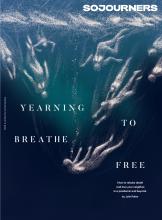IN HER STUNNING second novel, Brit Bennett, author of The Mothers, once again examines race and kinship. This time, she interrogates the color line through the Vignes twins—their coming of age and its impact on the subsequent generation. Born and raised in the fictional town of Mallard, La., the twins dream of escaping their stifling community. At 16, they run away together. In New Orleans, a desperate choice severs their bond: Stella passes as white to get a job, then leaves her sister Desiree in order to marry a white man.
Years later, when Desiree flees an abusive marriage and returns to Mallard with her daughter, Jude, the town is shocked by the child’s color: “black as tar,” “blueblack.” Having inherited her father’s complexion, Jude looks nothing like her mother. From its opening pages, The Vanishing Half grounds us in this “strange” town that, “like any other, was more idea than place.” The idea: a community for those “who would never be accepted as white but refused to be treated like Negroes.” An idea born of a freed slave, the twins’ ancestor, as he “stood in the sugarcane fields he’d inherited from the father who’d once owned him.”
Read the Full Article

